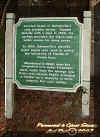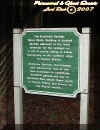|
|
||

Back around 500 B.C. the native American cultures were provided with fresh water from Boulware Springs. The area in the mid 1800s was eventually used by the locals in Gainesville for local swimming and picnicking. Like most springs people in Florida back then for a few centuries thought that springs like these could heal you or they served as fountains of youth. In 1891-92 Gainesville purchased the springs to provide water to the residents. The county seat from Newnansville was moved to this unnamed town at one time Gainesville was nameless just a little part of history I felt was relevant here and this place does tie into our Newnansville Investigation. By 1892 Gainesville's first central water works was built which was the sole source of Gainesville's drinking water from 1898 to 1913. The pump house was built in 1902 and has white brick walls, standing seam metal hip roof's, and segmented arches above several windows. The building is not fully restored but it still is in fairly good shape. The city of Gainesville convinced the University Of Florida to be located here rather then Lake City with an offer of free water from the springs. In the 1980's the area was designated as an American Water Landmark and was listed on the National Register Of Historic Places. The area is now a park and the springs discharge 300,000 gallons a day from the Floridian Aquifer. Near the water works is a very historical state trail called The Gainesville-Hawthorne State Trail. It stretches from 16 miles starting at Gainesville's Boulware Springs through the Payne's Prairie Preserve Park. It also stretches on into the Lochloosa Wildlife Management Area which is not to far from the Rawlings farm another area we investigated. See everything we do almost is connected. The trail was turned into a recreational narrow bike trail designed for walking, cycling, and even horseback riding. At one time this trail was actually a set of railroad tracks. Back many years ago it was surrounded by citrus groves, small railroad towns, and coal burning locomotives. They often nick name this route the Traders Path because it at one time stretched even further back in time when William Bartram explored the area, Seminole Indians lived off the land and Florida's first settlers traveled by wagon. The railway that was located area was used in hauling freight such as vegetables, fruit, lumber and even passengers in the 1800s. The state acquired the trail property in 1988 and 89 developing a trail. I think what would make this area so haunted is that it has a rich history surrounding it. The springs have been visited for hundreds of years just as this trail at time had a trail that stopped in many towns which are now ghost towns. This will always be a special investigation as it was our first in the Gainesville area and of course without the springs the very well known college which is downtown Gainesville would not have been built here. © By Lord Rick-LordOfThyNight
|
||
|
|
|






















